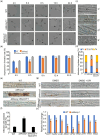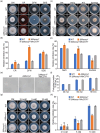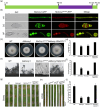Golgin Protein MoCoy1 Mediates Retrograde Trafficking From the Golgi to the ER, Regulating Fungal Development and Pathogenicity in Magnaporthe oryzae
- PMID: 40700342
- PMCID: PMC12285743
- DOI: 10.1111/mpp.70130
Golgin Protein MoCoy1 Mediates Retrograde Trafficking From the Golgi to the ER, Regulating Fungal Development and Pathogenicity in Magnaporthe oryzae
Abstract
The Golgi apparatus is a vital organelle involved in protein sorting and trafficking. Golgins, a family of coiled-coil proteins, play an important role in maintaining the structure and function of the Golgi apparatus in eukaryotes. However, the function of golgins in the plant-pathogenic fungus Magnaporthe oryzae remains uncharacterised. Here, we systematically investigated the biological role of the golgin protein MoCoy1 in M. oryzae. Our results show that MoCoy1 is primarily localised to the Golgi apparatus. MoCOY1 deletion led to defects in vegetative growth, conidiation and pathogenicity of M. oryzae. In addition, MoCoy1 affected the secretion of the cytoplasmic effector proteins. Furthermore, MoCoy1 interacted with retrograde Golgi-related components and affected the retrograde transport from the Golgi to the endoplasmic reticulum (ER). Overall, our findings suggest that the golgin protein MoCoy1 mediates ER-Golgi retrograde trafficking, thereby regulating the development and pathogenicity of M. oryzae.
Keywords: Magnaporthe oryzae; Golgins; MoCoy1; pathogenicity; retrograde trafficking.
© 2025 The Author(s). Molecular Plant Pathology published by British Society for Plant Pathology and John Wiley & Sons Ltd.
Conflict of interest statement
The authors declare no conflicts of interest.
Figures








Similar articles
-
Recycling of Trans-Golgi SNAREs Promotes Apoplastic Effector Secretion for Effective Host Invasion in Magnaporthe oryzae.Plant Cell Environ. 2025 Aug;48(8):6047-6065. doi: 10.1111/pce.15582. Epub 2025 Apr 29. Plant Cell Environ. 2025. PMID: 40302198
-
Decarboxylase mediated oxalic acid metabolism is important to antioxidation and detoxification rather than pathogenicity in Magnaporthe oryzae.Virulence. 2025 Dec;16(1):2444690. doi: 10.1080/21505594.2024.2444690. Epub 2025 Jan 26. Virulence. 2025. PMID: 39814555 Free PMC article.
-
Dihydroorotase MoPyr4 is required for development, pathogenicity, and autophagy in rice blast fungus.Cell Commun Signal. 2024 Jul 15;22(1):362. doi: 10.1186/s12964-024-01741-4. Cell Commun Signal. 2024. PMID: 39010102 Free PMC article.
-
Epigenetic modulation of fungal pathogens: a focus on Magnaporthe oryzae.Front Microbiol. 2024 Oct 28;15:1463987. doi: 10.3389/fmicb.2024.1463987. eCollection 2024. Front Microbiol. 2024. PMID: 39529673 Free PMC article. Review.
-
Amyotrophic Lateral Sclerosis: Focus on Cytoplasmic Trafficking and Proteostasis.Mol Neurobiol. 2025 Aug;62(8):10091-10117. doi: 10.1007/s12035-025-04831-7. Epub 2025 Apr 3. Mol Neurobiol. 2025. PMID: 40180687 Free PMC article. Review.
References
MeSH terms
Substances
Supplementary concepts
Grants and funding
LinkOut - more resources
Full Text Sources

